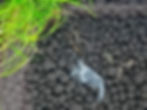

How To Breed Neocaridina Shrimp (Tips and Tricks)
Aug 8, 2024
4 min read
0
125
0

Neocaridina shrimp are a small, often vibrantly colored variety of freshwater shrimp commonly found in household aquariums worldwide.
Luckily for those looking to expand the size of their neocaridina shrimp shoal, they are also some of the easiest aquarium animals to successfully breed.
Raising Neocaridina takes place in 3 steps; Breeding, carrying eggs, and raising young.
To get started, you only need a sexed pair of shrimp, stable water parameters, and plenty of food.
Sexing Shrimp

While most neocaridina shrimp tend to be pretty uniform in appearance, several vital differences should allow you to quickly identify the gender of your shrimp so you can start breeding.
One of the most telling factors in determining the sex of your shrimp is size. Once fully grown, Male Neocaridina tend to be smaller than their female counterparts. Additionally, Males tend to be lighter in color, often appearing somewhat translucent.
Females, on the other hand, tend to be larger than their male counterparts. They are also most often a darker, richer color with a significantly lower level of apparent opacity.
Female neocaridina shrimp also tend to have a longer and rounder tail section. This is because they use their tail to hide and fan their eggs while they wait for their young to hatch,
When a female neocaridina shrimp becomes buried (Pregnant), a lump or saddle will appear near the top of her back. This lump is caused by the eggs as they make their way down through her body to her tail to be laid.

Water Parameters

Neocaridina shrimp can thrive in a variety of water parameters. This is a massive part of what makes them so popular as aquarium pets, as tap water or any clean drinking water usually offers them everything they need to thrive.
That said, water parameters must be kept stable during the breeding process.
The ideal water parameters for neocaridina shrimp are as follows:
Temperature: 65-80 F (18.3-26c)
PH: 7.2 - 7.6
Hardness: Hard
GH: 8
KH: 8
TDS: 250-300
I recommend you utilize test strips to ensure your water parameters are stable. Test once or twice per week for optimal results.`
Food Sources

Neocaridina shrimp eat various foods, including blanched vegetables, specialized shrimp food, flake fish food, algae, and, most commonly, biofilm, a type of algae that coats nearly every surface in a cycled aquarium.
Biofilm makes up the majority of neocaridina shrimp's diet. In fact, with a correctly set aquarium, you may never need to feed your shrimp, even during the breeding stages.
When feeding shrimp, it is essential to note that you should only let their food sit in the tank for a short time. Otherwise, it will rot and decrease the water quality in your aquarium. Also, shrimp are small creatures, so less is more when feeding them. We don't want you to have a dirty aquarium after all.
Breeding Process
Once your neocaridina shrimp are mature, assuming they are gendered correctly, they should begin to breed. This can start anywhere from four to six months into their life cycle.
Before mating, the female shrimp will molt. This makes them highly vulnerable, and you may notice that they tend to hide during this period to protect themselves from any perceived threats within your tank.

After molting, the female will release pheromones that alert male shrimp that they are ready to breed. You may notice that your male shrimp will act frantic during this time as they try to find and fertilize the eggs of the female shrimp.
After finding the female shrimp, the male deposits sperm into the female's egg compartment, fertilizing the eggs within the female shrimp.
After this process is completed, the fertilized eggs begin to travel down the shrimp's body from the saddle behind her head towards her tail, where they will be kept until hatching. This process creates a large bump on the shrimp's back, which makes tracking the process easy.

During this process, the eggs are constantly fanned by the female's pleopods, the small fin-like appendages that can be observed under the tail of your shrimp. This keeps them clean and forces oxygen into the unhatched eggs.
Raising Baby Neocaridina
Unlike most shrimp, which go into a larva stage after hatching from their eggs, baby neocaridina shrimp are identical replicas of their parents immediately after hatching. Baby Neocaridina eat the same combination of algae, biofilm, and shrimp foods as their parents.
If you want to offer them additional food, crush it up as small as possible, as larger particles can be challenging for the baby shrimp to ingest.

Because of their small size, baby neocaridina are highly susceptible to becoming a snack for any predatory fish in your aquarium. It is recommended that you do not keep baby neocaridina with predatory fish.
Additionally, baby neocaridinas prefer a planted environment with lots of spaces for them to hide. If you choose to keep them in an aquarium with additional fish, these places will keep your baby shrimp alive.
Plants like Java moss, Christmas moss, and other slow-growing, hearty aquarium plants provide excellent structure for your shrimp, offering shelter and growing microfauna for the shrimp to eat.

Baby neocaridina can easily be drawn into your aquarium's filter, killing them and your future hopes for a lively aquarium. I recommend that you use a sponge filter, as this will prevent any unnecessary deaths while providing excellent water circulation, filtration, and aeration for your aquarium.
Raising neocaridina shrimp is a rewarding process, and if you follow these steps, your aquarium should be full of beautiful, energetic shrimp sooner than you can imagine.






